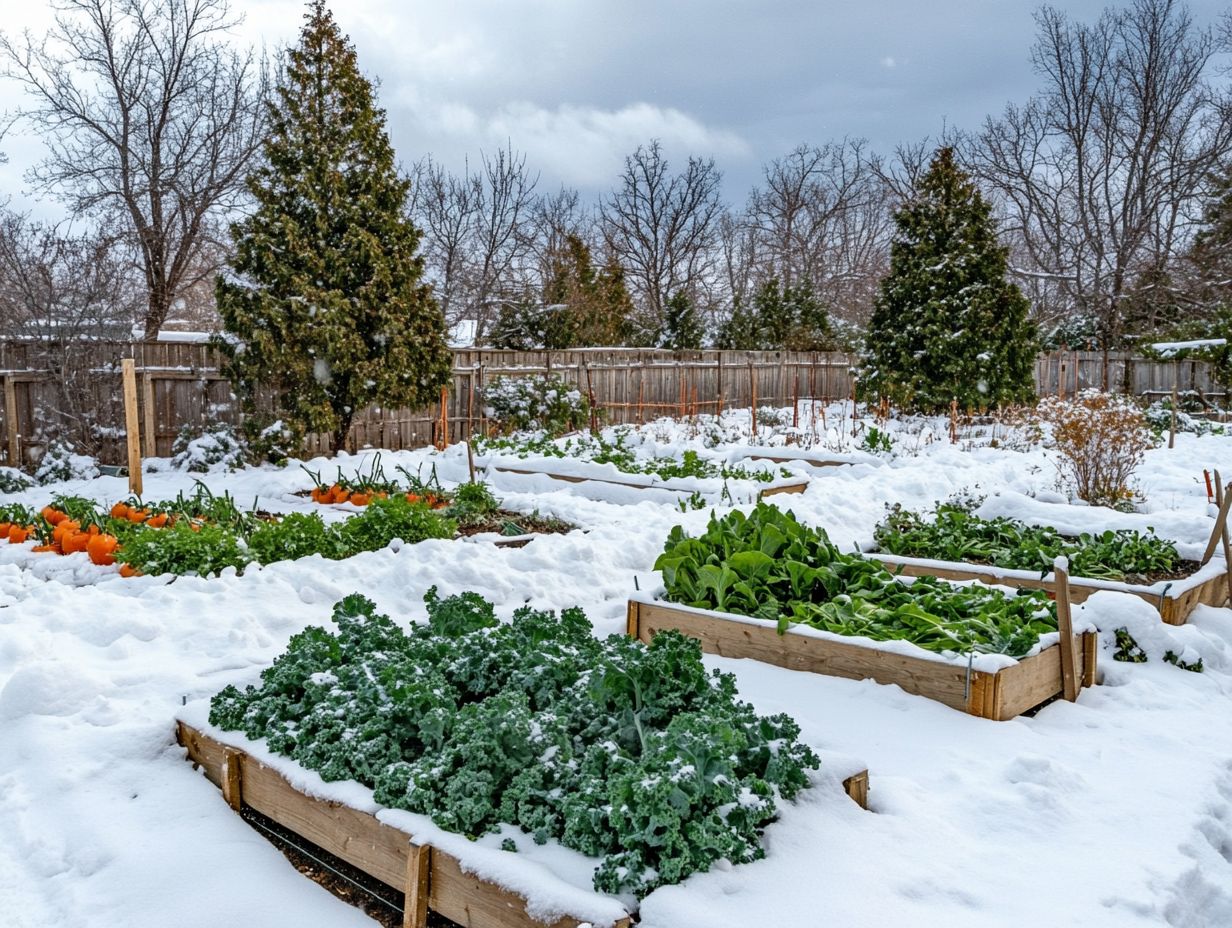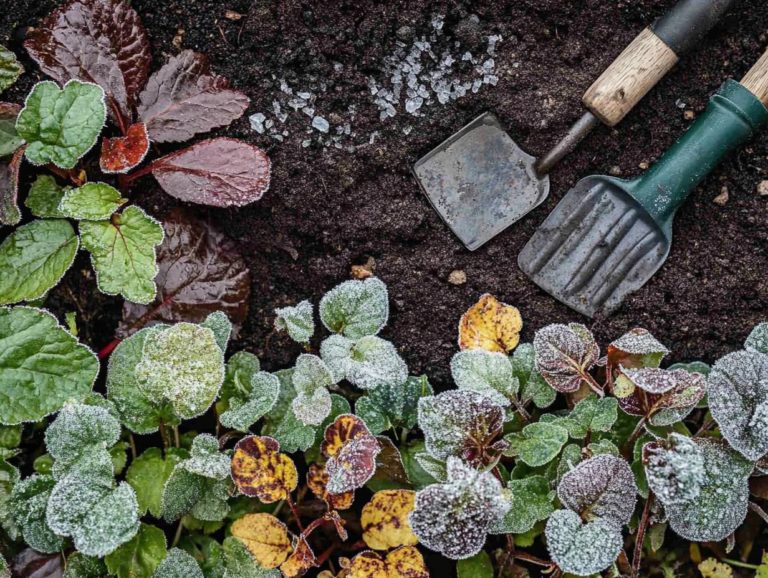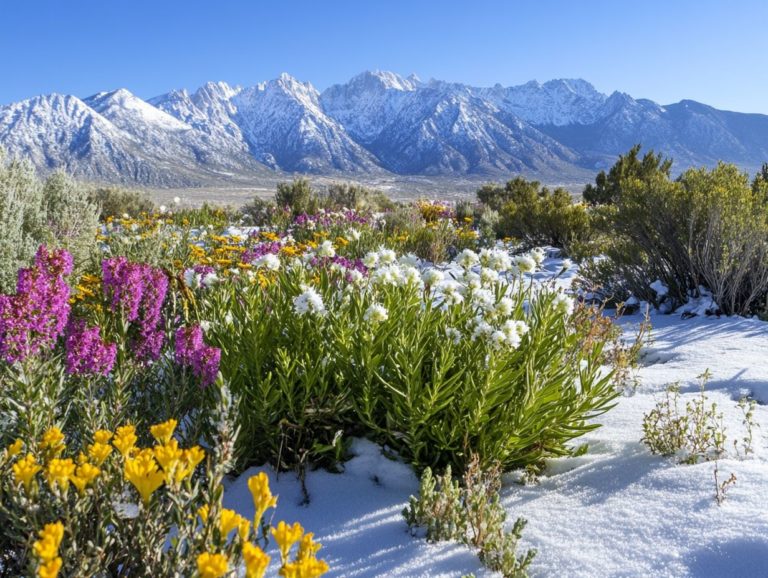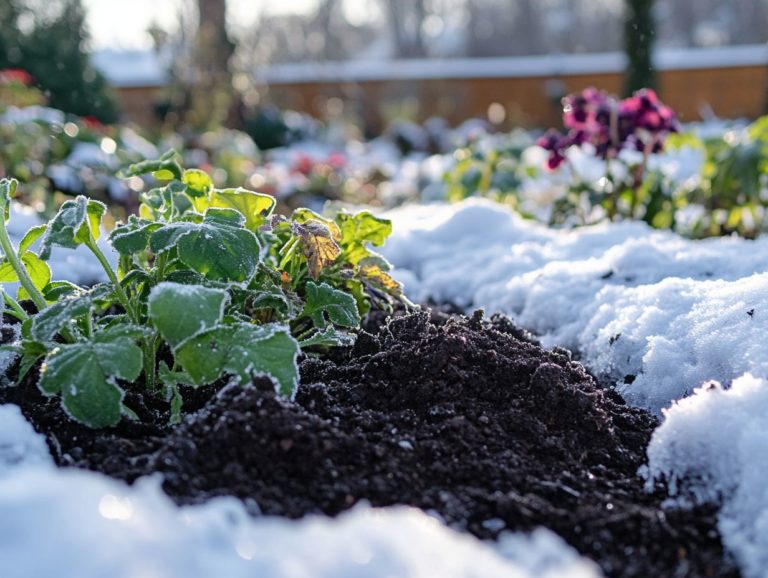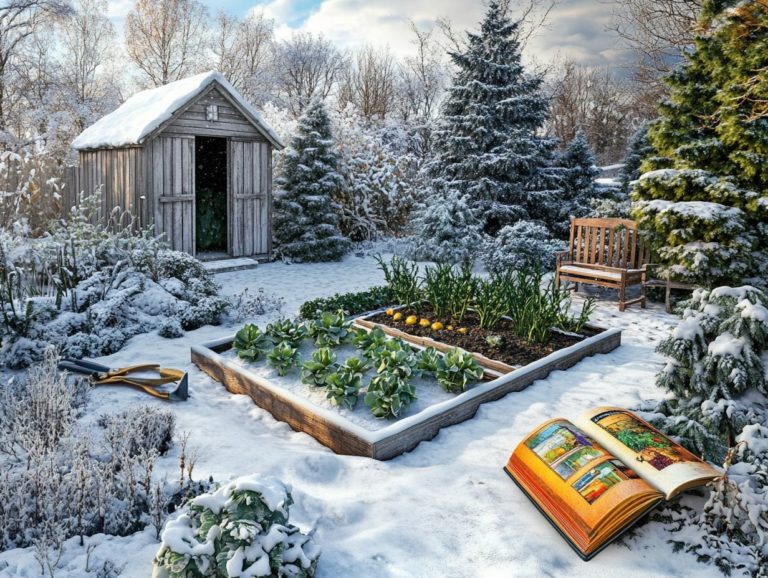How to Plan a Cold-Climate Vegetable Garden?
Gardening in cold climates may appear daunting at first glance, yet it unveils a remarkable array of opportunities for cultivating delicious and nutritious vegetables.
This guide delves into the distinct advantages of establishing a winter garden, highlighting benefits that range from enhancing your health to taking care of our environment.
It addresses vital factors such as climate and soil conditions, along with insights on selecting the right vegetables and effective planning strategies.
You ll discover practical tips for nurturing your garden and maximizing your harvest. Get ready to elevate your cold-weather gardening experience to new heights!
Contents
- Key Takeaways:
- What is Cold-Climate Gardening?
- Benefits of Growing a Cold-Climate Vegetable Garden
- Factors to Consider Before Planning
- Planning and Designing Your Garden
- Caring for Your Cold-Climate Vegetable Garden
- Harvesting and Enjoying Your Homegrown Vegetables
- Tips for Harvesting and Storing
- Frequently Asked Questions
- What are the best vegetables to grow in a cold-climate vegetable garden?
- When should I start planning my cold-climate vegetable garden?
- How do I prepare my soil for a cold-climate vegetable garden?
- What is the ideal location for a cold-climate vegetable garden?
- Can I start my cold-climate vegetable garden indoors?
- What are some techniques for extending the growing season in a cold-climate vegetable garden?
Key Takeaways:
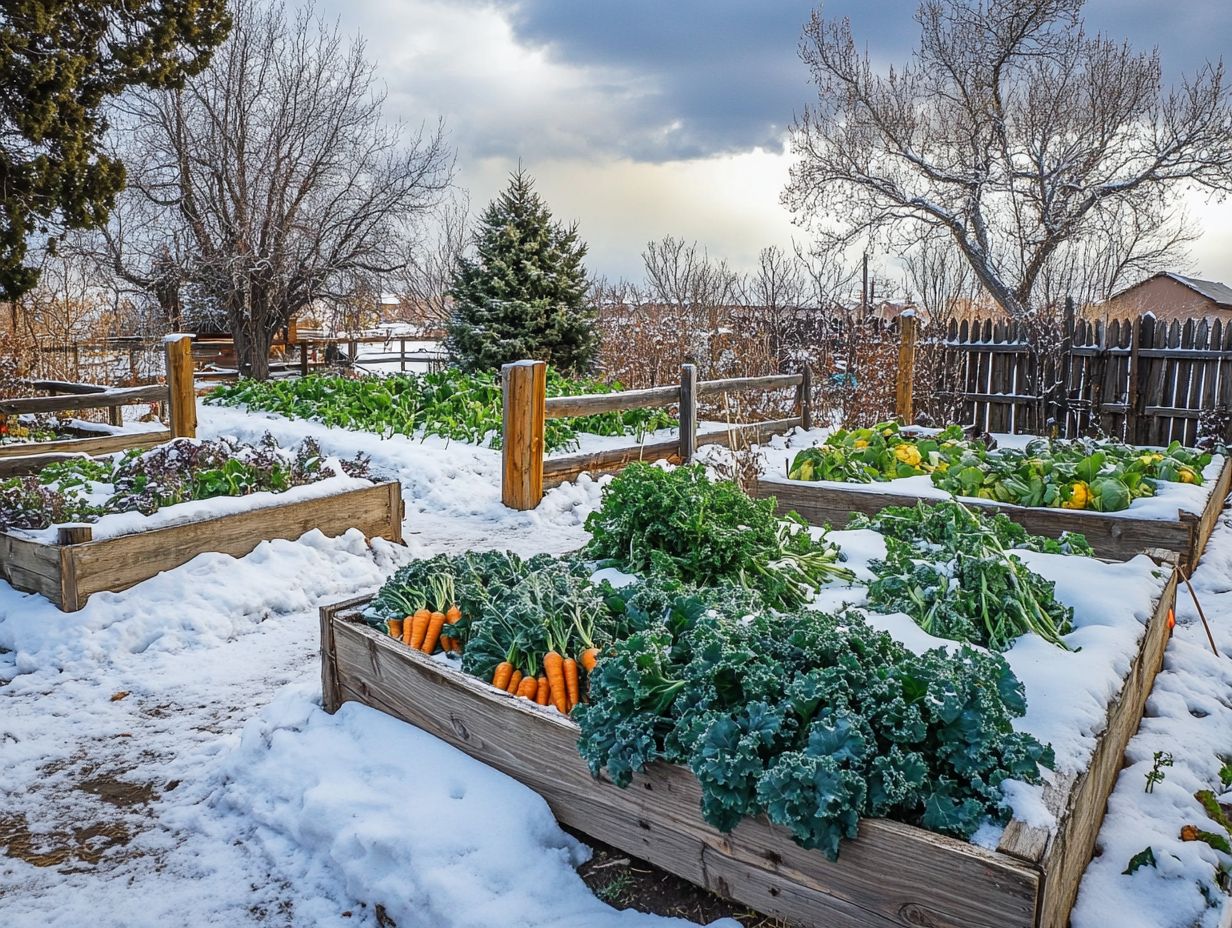
- Choose vegetables that thrive in colder climates. Consider factors such as temperature and soil conditions before planning your garden.
- Proper care, including watering, fertilizing, and pest control, is key to a successful winter garden.
- Harvest and enjoy your homegrown vegetables by following tips for harvesting and storing them properly.
What is Cold-Climate Gardening?
Cold-climate gardening is all about cultivating plants in regions where winter chills can be unforgiving. You can still flourish despite the dropping temperatures by planning your 2024 garden in cold climates. This approach not only champions sustainable vegetable gardening but also skillfully extends your growing season.
By employing techniques like cold frames structures that protect plants from cold weather row covers, mini hoop houses, and greenhouses, you can effectively shield your crops and stimulate growth during the colder months.
Visionaries in this arena, such as Rick Stone at Our Stoney Acres in Utah, have crafted strategies that unlock the full potential of hardy vegetables. They transform winter gardening into a truly rewarding pursuit for those passionate about it.
Benefits of Growing a Cold-Climate Vegetable Garden
Cultivating a winter garden offers a wealth of advantages, enabling you to harvest fresh produce in winter. Engaging in cold-weather gardening yields nutritious crops and plays a vital role in reducing the carbon footprint linked to food transportation.
By embracing local, organic gardening practices, you can grow a diverse array of hardy vegetables like collards, spinach, kale, and Swiss chard, all of which provide essential health benefits during the colder months. These advantages foster a sustainable lifestyle that reinforces community resilience and enhances food security.
Environmental and Health Benefits
The environmental and health benefits of cold-weather gardening are truly remarkable. This sustainable approach to food production aligns perfectly with organic gardening principles.
When you grow vegetables like carrots, parsnips, and beets during the winter months, you’re not just cultivating your own food; you’re also contributing to local biodiversity and reducing reliance on commercial agriculture.
This practice also boosts your well-being by giving you access to fresh, nutritious produce while fostering a deeper connection to the land. It encourages healthier eating habits and cultivates an appreciation for seasonal cycles.
Engaging in this style of gardening significantly reduces your carbon footprint by minimizing transportation emissions linked to imported produce. By nurturing a diverse array of plants, you create habitats for beneficial insects and wildlife, enriching local ecosystems in the process.
Tending to a winter garden can also serve as a therapeutic outlet, offering psychological benefits such as stress reduction and improved mood. The immersive experience of watching seeds transform into food can amplify your sense of accomplishment and strengthen your bond with nature, fostering a holistic approach to health and well-being.
Ready to get started? Plant your first seeds today and enjoy the rewards of winter gardening!
Factors to Consider Before Planning
Before you start cold-climate gardening, consider key factors for success in vegetable gardening.
Understanding your local climate, like temperature swings and frost dates, is essential for selecting planting techniques and crops.
Evaluate your soil conditions, as they affect the growth of hardy vegetables.
Thoughtful preparation, such as building cold frames or using row covers, can protect your plants and lead to a thriving garden.
Climate and Soil Conditions
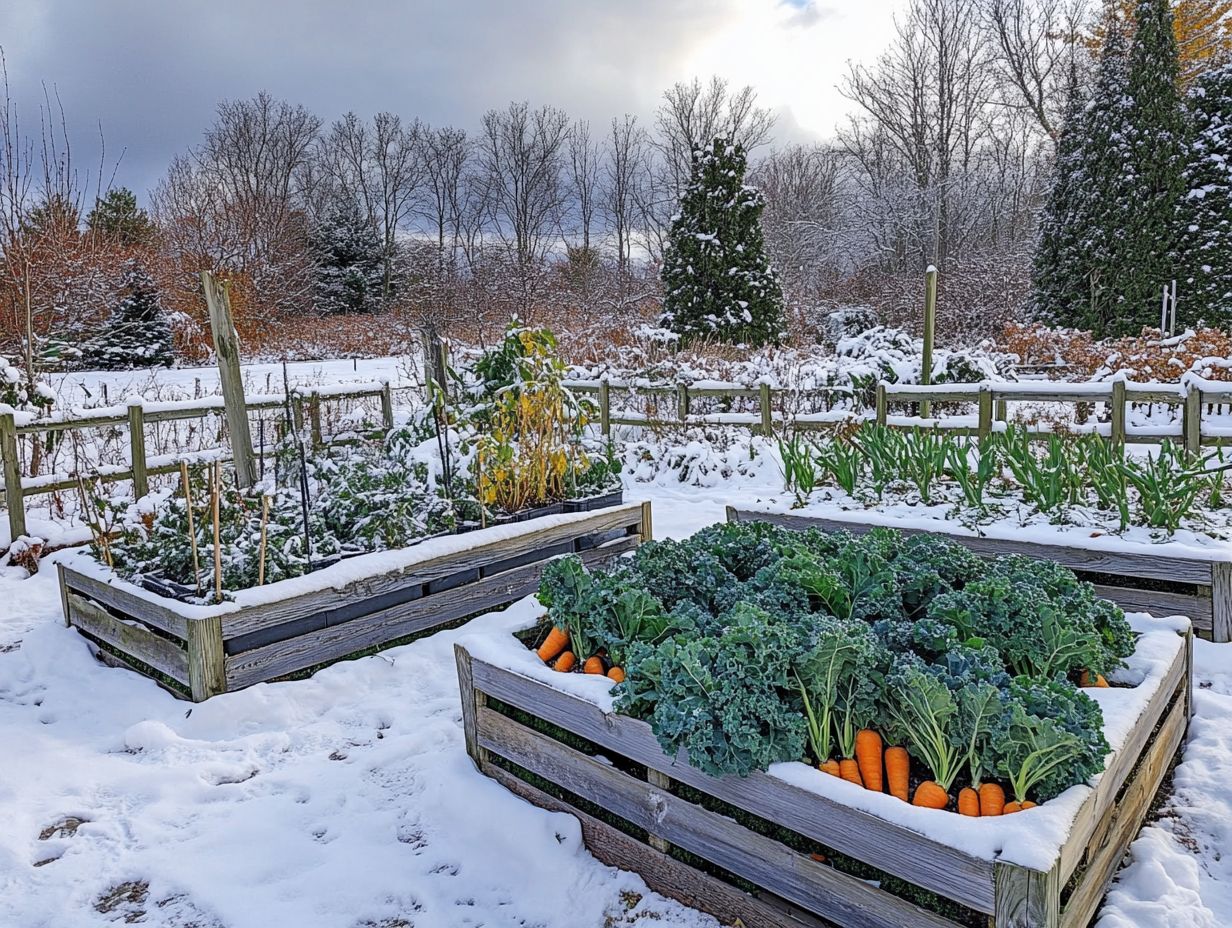
Knowing your climate and soil conditions is essential for success in cold-weather gardening.
These factors directly impact the types of crops you can grow and their overall health.
In areas like Utah, where winter temperatures are extreme, choose hardy vegetables like lettuce, Brussels sprouts, and radishes.
This selection leads to a fruitful harvest when applying effective cold-climate gardening techniques.
In challenging environments, temperature fluctuations and soil frost greatly influence germination and root development.
Sandy soils might drain quickly but can deplete nutrients, while clay soils retain water and risk root rot.
Understanding how different soil types work with your climate is vital for maximizing crop yield.
Adding soil amendments like compost improves drainage and nutrient availability, helping you choose the right vegetables for tough conditions.
Choosing the Right Vegetables
Selecting the right vegetables is crucial for maximizing your harvest in cold climates.
Opt for hardy varieties like bok choy, turnips, and radishes, as they thrive in the cold.
Use effective planting tips tailored to the climate to ensure your crops not only survive but flourish.
Frost-resistant varieties withstand low temperatures and often develop better flavors.
Timing your planting with soil warmth creates an ideal environment for germination.
Using mulch helps regulate soil temperature and moisture levels for your plants.
Consider season extenders like row covers or cold frames to protect seedlings from frost.
These tools can lengthen your growing season, ensuring a fruitful garden year-round!
Planning and Designing Your Garden
Effective planning and designing of your cold-climate vegetable garden are crucial for a productive growing season, especially when you know how to start a cold-climate garden.
Thoughtfully consider your garden layout and strategic planting techniques for an optimal environment.
Tools like mini hoop houses or row covers improve growing conditions, allowing a wider range of crops to thrive in winter.
Layout and Planting Strategies
Effective garden layout and planting strategies can boost the success of your cold-climate vegetable garden, especially when you know what vegetables grow best in cold climates.
By positioning your garden for southern exposure, you maximize sunlight, which is essential for growing vegetables like collards and kale. Embracing different gardening methods, such as companion planting growing certain plants together to help each other and staggered sowing can enhance yield and resilience against harsh winter conditions.
Incorporating raised beds can transform your gardening experience, allowing for superior drainage and warmer soil temperatures, which are critical in cooler regions. Introducing windbreaks, like hedges or fences, protects delicate plants from biting winds that often sweep through cold climates.
Techniques such as mulching conserve moisture and help regulate soil temperature, making roots less vulnerable to freezing.
Ultimately, the interplay of these strategies creates a thriving environment, ensuring you can enjoy abundant harvests despite the challenges posed by your location.
Caring for Your Cold-Climate Vegetable Garden
Caring for your cold-climate vegetable garden requires a tailored approach, including planning your winter vegetable garden layout, to maintain the health and productivity of your plants throughout the winter months.
Mastering proper watering techniques is important, along with using the right fertilizers that cater specifically to the needs of hardy vegetables.
Moreover, adopting smart pest control strategies is important to keep pests away during winter and safeguard your crops from potential threats.
Watering, Fertilizing, and Pest Control
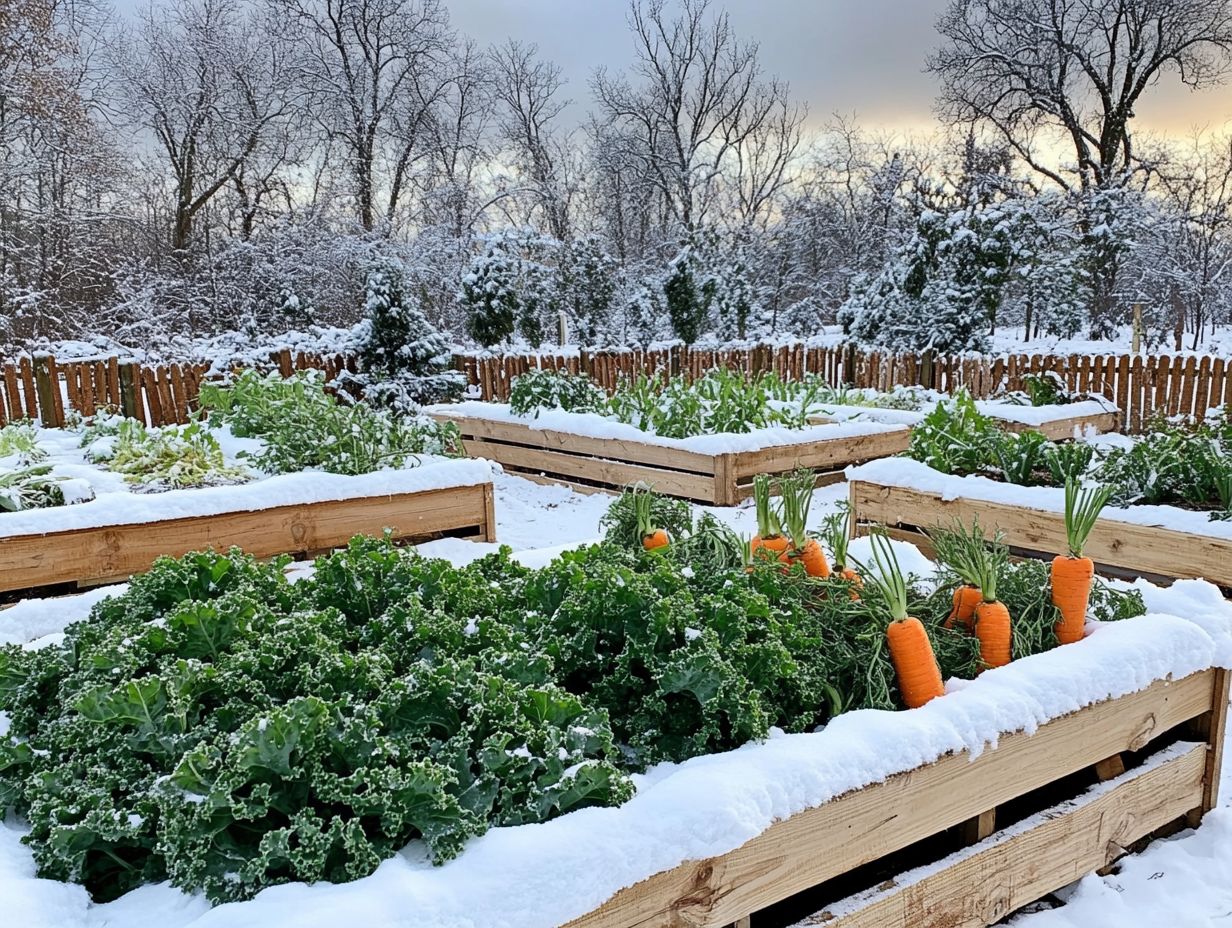
Effective watering, fertilizing, and pest control are essential for successfully managing a cold-climate vegetable garden. To understand the challenges of cold-climate gardening, keep in mind that in winter gardens, deep watering often trumps frequent shallow watering, while choosing organic fertilizers can significantly bolster your plant health.
By using eco-friendly pest control methods, you ll love how robust your vegetables like spinach and beets become throughout the growing season. Understanding the unique needs of your plants in cold temperatures can dramatically enhance their resilience.
For example, mulching techniques not only conserve moisture but also regulate soil temperature, creating a hospitable environment for roots. Integrating beneficial insects and natural repellents will help safeguard your crops while keeping your approach organic.
Regularly monitoring for signs of disease, especially during harsher months, allows you to take proactive measures. Embrace these tailored strategies and learn about the key principles of cold-climate gardening to ensure that your vegetable garden flourishes, yielding bountiful harvests even in challenging weather conditions.
Harvesting and Enjoying Your Homegrown Vegetables
Harvesting and savoring your homegrown vegetables is the pinnacle of cold-climate gardening, allowing you to enjoy the fruits of your labor even during winter’s chill.
It’s crucial to time your harvest perfectly; this ensures that crops like carrots, parsnips, and lettuce maintain their nutritional value and flavor. Additionally, using smart storage techniques can extend the freshness of your produce, letting you relish the vibrant flavors of your garden long after the last frost has come and gone.
Tips for Harvesting and Storing
Utilizing effective harvesting and storage techniques is essential for maximizing the bounty from your cold-climate garden. To preserve the freshness of your homegrown vegetables, harvest crops like radishes and beets at their peak ripeness. This boosts both flavor and nutritional value.
You can extend shelf life by using methods such as root cellaring, which involves storing root vegetables in a cool, dark, and moist environment, and breathable containers for better air circulation.
The right time to harvest varies from crop to crop. For example, leafy greens should be picked during cooler morning hours to maintain their crispness, while squash thrives when harvested just before the first frost.
After gathering a successful harvest, maintaining best temperature and humidity levels is vital. For winter crops, root vegetables should be stored in dark, cool, and moist conditions. Meanwhile, herbs can be air-dried or frozen in ice cube trays to capture their essence.
Embrace these strategies and enjoy your harvest all winter long!
Frequently Asked Questions
What are the best vegetables to grow in a cold-climate vegetable garden?
Some of the best vegetables to grow in a cold-climate vegetable garden include root vegetables like carrots, beets, and potatoes, as well as leafy greens like kale, spinach, and what are the best cold-weather gardening techniques.
When should I start planning my cold-climate vegetable garden?
It is recommended to start planning your cold-climate vegetable garden in late winter or early spring. This timeframe allows you to prepare the soil and choose the right plants for your area, as well as learn how to use greenhouses for cold-climate gardening.
How do I prepare my soil for a cold-climate vegetable garden?
To prepare your soil, first clear the area of any debris or weeds. Then, mix compost or organic matter to improve the soil’s nutrient content and drainage.
What is the ideal location for a cold-climate vegetable garden?
The ideal location receives at least 6 hours of sunlight per day and has good drainage. It should also be protected from strong winds and have easy access to water.
Can I start my cold-climate vegetable garden indoors?
Yes, you can start your cold-climate vegetable garden indoors using seed starting trays or pots and a grow light. This helps extend your growing season and gives your plants a head start before transplanting them outdoors. For more information, check out the resources available for cold-climate gardeners.
What are some techniques for extending the growing season in a cold-climate vegetable garden?
Techniques to extend the growing season include using row covers, cold frames, and mulch to protect plants from frost. You can also plant cold-tolerant varieties and stagger your plantings for a continuous harvest.
Have more questions? Let us know in the comments below!

